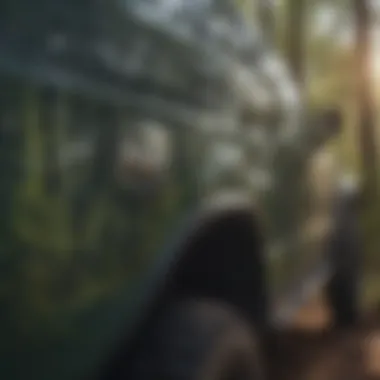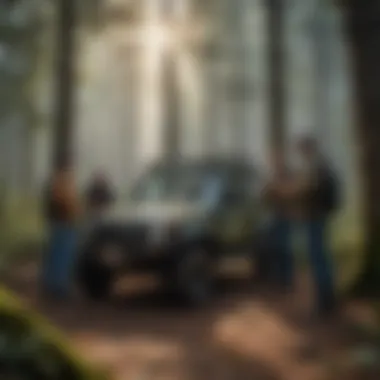Understanding the ORV Sticker: A Guide for Enthusiasts


Intro
The management of off-road vehicle (ORV) use within forest ecosystems is increasingly important for maintaining the delicate balance of these natural habitats. An ORV sticker serves a vital function in regulating these activities. This article will delve into the intricate relationship between ORV stickers and sustainable forestry practices, highlighting their significance for both environmental protection and responsible recreational enjoyment.
Understanding the implications of ORV stickers is essential for both enthusiasts and professionals involved in forestry. This guide will offer insights into various types of ORV stickers, the legal obligations they entail, and their broader environmental consequences. By examining these factors, we aim to promote responsible usage of off-road vehicles in forests while ensuring the longevity and health of forest ecosystems.
Preface to ORV Stickers
Off-road vehicle (ORV) stickers have a significant role in maintaining the balance between recreation and environmental stewardship. Understanding these stickers is essential for anyone who engages in off-road activities in forested areas. This section aims to clarify what ORV stickers are and conveys their importance in the realm of forest management.
These stickers are not merely bureaucratic obligations; they symbolize compliance with legal regulations designed to protect natural resources. They provide a framework for responsible use while also serving as a method for funding trail maintenance and conservation programs. By requiring users to adhere to specific guidelines, ORV stickers contribute to sustainable outdoor activities that can be enjoyed for generations.
Definition and Purpose
An ORV sticker is a decal issued by state or local authorities that permits the use of off-road vehicles in designated areas. This sticker denotes that the vehicle meets certain legal standards for operation. Primarily, it signifies that the user has paid the necessary fees and complied with safety requirements.
The purpose extends beyond simple authorization. These stickers are crucial for reinforcing the idea that off-road vehicles should be used responsibly. They help to monitor and regulate vehicle usage in sensitive environments, ensuring that impacts on flora and fauna are minimized. This regulation is particularly significant in areas prone to erosion and habitat loss.
Importance in Forest Management
The importance of ORV stickers in forest management cannot be overstated. They directly link the recreational activities of users to the preservation of natural ecosystems. Proper sticker usage helps manage traffic in popular areas, thereby reducing environmental strain.
By limiting off-road vehicle access to designated trails, forest officials can mitigate issues such as:
- Soil Erosion: Off-road vehicles can cause significant soil displacement. Stickers help enforce usage rules that direct vehicles away from vulnerable terrains.
- Wildlife Disruption: Many species are sensitive to noise and human activity. ORV stickers help control the areas where vehicles can operate, thus allowing wildlife to thrive.
- Resource Allocation: The fees associated with obtaining stickers often fund trail maintenance and conservation programs. This funding is essential for preserving the very landscapes that users enjoy.
It is evident that ORV stickers are more than just identification tags; they serve as a vital component of forest management strategies. Engaging with this system enriches the recreational experience while protecting our natural environments.
Types of ORV Stickers
The different types of Off-Road Vehicle (ORV) stickers play a crucial role in understanding forest management and user responsibilities. Each state has distinct regulations that govern how ORV stickers function. Knowing the various types helps users comply with laws and minimize environmental impact. The classification of various ORV stickers aids in distinguishing between different uses, requirements, and purposes.
State-Specific Regulations
State-specific regulations are vital for effective ORV management. Each region has unique guidelines based on local environmental conditions and public safety needs. For example,states such as California and Michigan have diverse policies that may differ considerably.
Risk management is a key element in these regulations. They establish where ORVs can be operated legally, ensuring that sensitive areas remain protected. Furthermore, these rules also dictate the necessary sticker types based on the kind of vehicle and user experience.


For instance, in places like Oregon, operators need a distinct sticker based on whether they are using an ATV or a dirt bike. Simply failing to acquire the correct sticker can lead to fines and illegal use in restricted areas. This illustrates the importance of checking state regulations before off-roading to ensure compliance.
Different Categories of ORV
Different categories of ORVs demand specific stickers, allowing for better tracking of usage patterns and compliance. These categories typically include all-terrain vehicles (ATVs), dirt bikes, snowmobiles, and more. Understanding these distinctions helps users select the right sticker that fits their vehicle type and intended use.
For example, ATVs generally require a different kind of sticker than snowmobiles, which must be used only in designated winter areas. Similarly, in some states, certain trails may be reserved for specific vehicle types, necessitating a proper sticker to use them legally.
Furthermore, categorization of ORVs aids in establishing conservation efforts. By knowing what kinds of vehicles are present in different areas, agencies can better manage resources and plan for sustainability efforts. In summary, understanding ORV types and their regulations ensures both the longevity of forest ecosystems and a positive experience for users.
"Each state’s unique regulations highlight the importance of being informed before any off-road adventures."
Obtaining an ORV Sticker
Obtaining an ORV sticker is a crucial step for anyone looking to use off-road vehicles legally and responsibly in forested areas. A valid sticker not only ensures compliance with state regulations but also signals a commitment to sustainable usage of outdoor spaces. Engaging in off-road activities without this necessary certification can lead to significant consequences for both the user and the environment. Understanding the application process and required documentation is vital for a smooth and efficient acquisition.
Application Process
When applying for an ORV sticker, one must follow very specific steps. First, checking the specific regulations in your state is essential. Each state has its procedures, fees, and deadlines which can affect how quickly you obtain your sticker. Typically, the process can initiate online through the state’s Department of Natural Resources website or at a local office.
- Visit the official website - Look for the specific section related to ORV registration. This will guide you on the requirements.
- Complete the application form - Fill out the online form or take a physical one at the office. Make sure all information is accurate and up-to-date.
- Pay applicable fees - Fees can vary according to the ORV category or duration of authentication. Ensure you have a method of payment ready.
- Submit your application - After checking everything, submit your form either electronically or in person.
- Await confirmation - Once submitted, expect some time for processing. Keep an eye on any communications from the regulatory agency.
Required Documentation
Understanding the necessary documentation is key to preventing delays in receiving your ORV sticker. Commonly, the following documents are needed:
- Proof of Identity - Generally, a valid driver's license or state ID is required. This serves to verify your identity.
- Vehicle Registration - You must provide proof that your ORV is registered. This document indicates that your vehicle complies with state regulations.
- Insurance Information - Some states require proof of insurance coverage for your ORV. Check if this applies to your location.
- Payment Receipt - Keep a copy of the payment receipt for your records. This can be helpful in case of disputes about payment or sticker issuance.
Obtaining an ORV sticker is not just a legal requirement; it is a commitment to responsible usage of forest ecosystems.
Following these steps and gathering the appropriate documents will ease the process of obtaining an ORV sticker. Forest enthusiasts should prioritize this task to enjoy off-road activities without legal concerns and contribute positively to environmental stewardship.
Legal Responsibilities of ORV Users
The use of Off-Road Vehicles (ORVs) comes with a series of legal responsibilities that every user must understand. These responsibilities are crucial, not only for the individual rider but also for the broader forest ecosystem. Compliance with established laws ensures safer environments for both users and wildlife. Being informed about these regulations promotes better stewardship of the land, preserving it for future generations.
Users must also recognize that these legal obligations vary greatly from one region to another. State and local regulations might have different stipulations about where ORVs can operate. Therefore, knowing the specific laws in your area helps to avoid unintentional violations, which can lead to serious penalties.


Compliance with Local Laws
Compliance with local laws is a fundamental responsibility of all ORV users. Each locality establishes its own regulations regarding ORV usage. This may include designated trails, operational hours, and restrictions on vehicle types. Understanding and adhering to these laws is essential for several reasons:
- Enhances Safety: Compliance reduces the risk of accidents, ensuring safer experiences for all users.
- Protects Natural Resources: Following regulations helps minimize environmental degradation, ranging from soil erosion to disruption of wildlife habitats.
- Legal Protection: Abiding by the law shields users from fines and legal actions, fostering a more enjoyable recreational experience.
It is advisable for users to review local ordinances regularly. This can include visiting official state or county websites to stay informed. Engaging with local ORV clubs can also be beneficial, as they often provide up-to-date information on best practices and regulations.
Penalties for Non-Compliance
The consequences of failing to comply with ORV laws can be significant. Users who do not adhere to regulations can face various penalties, which may include:
- Fines: Monetary penalties can range from modest fines to substantial amounts, depending on the severity of the violation.
- Vehicle Impoundment: In some cases, authorities may impound the off-road vehicle until the necessary legal issues are resolved.
- Loss of Riding Privileges: Repeat offenders may find themselves banned from certain areas or trails, limiting their recreational options.
Understanding these penalties underscores the importance of responsible ORV use. Violations not only impact individual users but can also harm the reputation of the entire off-road community.
By adhering to the regulations, ORV users demonstrate their commitment to sustainable use and the preservation of natural areas.
Environmental Impact of ORV Use
The environmental impact of Off-Road Vehicles (ORVs) is a critical aspect discussed in this article. Understanding these effects helps stakeholders, including forestry professionals and outdoor enthusiasts, to make informed decisions. Recognizing how ORV usage affects the ecosystem promotes responsible recreation and aids in developing regulation strategies. Let's delve into specific areas of concern, such as erosion, wildlife effects, and conservation challenges.
Erosion and Soil Damage
ORV use significantly contributes to erosion and soil damage in forest areas. When vehicles traverse these landscapes, their weight compresses the soil, affecting its structure. This compression reduces soil porosity, which in turn limits water infiltration. As a result, more water runs off the surface, leading to increased erosion. The effects are visible as sediment washes into nearby streams and rivers. This sediment can damage aquatic habitats and alter the water quality.
In areas with soft or loose soils, the impact can be even more pronounced. Tires create grooves and ruts that retain water, leading to further erosion. Over time, such alterations can prevent the growth of native plants, disrupting local ecosystems. It is essential for ORV users to recognize these consequences and choose paths wisely. Sustainable trail design can mitigate these issues, but awareness must be paired with responsible driving.
Impact on Wildlife
The impact of ORV use on wildlife is a multifaceted concern. Various species depend on serene forest environments for their survival. Loud noises and fast-moving vehicles can displace wildlife, causing stress and altering their natural behavior. For instance, deer and other herbivores may flee their feeding grounds due to the presence of ORVs, negatively affecting their health and reproduction.
Additionally, ORV trails often carve through critical habitats, fragmenting populations. This fragmentation can hinder migration routes, limit access to food, and reduce genetic diversity. Amphibians, reptiles, and ground-nesting birds are particularly vulnerable. They rely on intact habitats to complete their life cycles. Educating users on the timing and areas to avoid can help protect these sensitive species. Efforts like wildlife corridors can serve as solutions.
Conservation Challenges
Conservation in areas popular with ORV users faces numerous challenges. One of the primary problems is maintaining a balance between recreational use and ecological preservation. Many forests have designated trails aimed at limiting environmental degradation. However, there is often resistance to these regulations. Enthusiasts may feel constrained by rules, leading to unauthorized off-trail riding.


Furthermore, funding for conservation efforts can be limited. Government resources may prioritize immediate recreational infrastructure over long-term environmental health. This imbalance makes it difficult for conservation organizations to implement effective measures. Engaging the public in conservation initiatives, like trail clean-ups or educational workshops, can foster cooperation between recreational users and conservationists.
In summary, the environmental impact of ORV use is considerable. By understanding issues relating to erosion, wildlife, and conservation, users can better appreciate the importance of responsible practices. Sustainable ORV use not only protects nature but also ensures future generations can enjoy these beautiful forested landscapes.
Sustainable Practices for ORV Users
The significance of sustainable practices for Off-Road Vehicle (ORV) users cannot be overstated. As the popularity of off-roading continues to rise, it is increasingly essential for enthusiasts to engage responsibly with forest ecosystems. Sustainable practices foster environmental stewardship, ensuring that recreation does not come at the cost of ecological degradation. This section explores best usage practices and ways to participate in conservation efforts, aiming to weave together an understanding of how individual actions contribute to the broader goal of preserving our natural landscapes.
Best Usage Practices
Adopting best usage practices is crucial for minimizing the environmental impact of ORV activities. Here are several key recommendations:
- Stick to Designated Trails: One of the simplest yet most effective practices is to utilize only approved paths. This helps in reducing soil erosion and preventing habitat disruption.
- Avoid Wet Conditions: Operating an ORV in wet areas can exacerbate erosion. Wait until conditions dry to ensure minimal impact on the terrain.
- Maintain Your Vehicle: Regular maintenance can prevent oil leaks and other malfunctions that could harm the environment. Keeping your vehicle in good shape contributes to cleaner trails.
- Practice Noise Minimization: Excessive noise can disturb wildlife. Using mufflers or choosing quieter models can help mitigate this issue.
Implementing these best practices allows ORV users to enjoy the outdoors while protecting the environments they cherish.
Participating in Conservation Efforts
Engaging in conservation initiatives can enhance the sustainability of ORV use. By taking a proactive stance, users can play a significant role in maintaining forest health. Here are a few ways to effectively participate:
- Join Local Conservation Groups: Organizations focused on forest preservation often welcome volunteers for various projects. This may involve trail maintenance or habitat restoration efforts.
- Advocate for Responsible Policies: Engage with local government about trail management and conservation policies. Promoting responsible regulations ensures that forest ecosystems remain healthy.
- Educate Others: Sharing knowledge about sustainable practices with fellow enthusiasts can foster a culture of stewardship. Leading by example often inspires others to follow suit.
Participating in conservation helps bridge the gap between recreation and preservation, promoting a culture of responsibility among ORV users.
These efforts not only contribute to the health of the ecosystems but also enrich the experiences of all forest enthusiasts. By committing to these sustainable practices, ORV users can ensure their activities support rather than undermine the beauty of our natural worlds.
Epilogue
The final section of this article serves as a critical reflection on the overarching themes discussed. Responsible use of off-road vehicles is fundamental for both the enjoyment of enthusiasts and the preservation of our forest ecosystems. ORV stickers play a vital role in managing access, ensuring that users understand their responsibilities and the environmental impact of their activities.
Importance of Responsible ORV Use
Responsible ORV use is paramount. It prevents damage to trails and habitats, promotes safe riding, and cultivates respect among different user groups within natural spaces. When individuals operate their vehicles in accordance with regulations, they contribute to sustainable practices that protect wildlife and preserve the integrity of forest environments. Here are some key facets of responsible ORV use:
- Adherence to Established Trails: Following marked paths minimizes ecological disruption.
- Observing Seasonal Restrictions: Certain areas may be closed or restricted during wildlife breeding seasons. Awareness of these rules is essential.
- Educating Others: Enthusiasts can influence peers by exemplifying proper behavior.
- Community Involvement: Engaging in local conservation efforts strengthens community ties and emphasizes mutual respect.
Future of ORV Regulations
The future of ORV regulations is likely to evolve as environmental concerns grow. Stricter guidelines may emerge based on ongoing research about the impact of off-road vehicles. Here are points to consider for the future:
- Technology Integration: Innovative tracking and monitoring technology may be implemented to ensure compliance.
- Policy Development: Agencies may revise regulations to enhance sustainable practices, like imposing limits on areas open to ORVs.
- Public Engagement: Increasing awareness through education programs will help foster responsible riding among new users.
- Partnerships: Collaborations between government, non-profits, and user groups may lead to better management strategies.
As we conclude, it is clear that the ORV sticker is not merely a permit; it embodies the responsibility shared by all who venture into these cherished landscapes. Keeping our forests healthy and our recreational spaces vibrant is a collective responsibility that requires vigilance and commitment from every ORV user.







